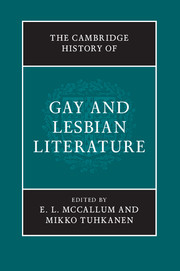Book contents
- The Cambridge History of Gay and Lesbian Literature
- The Cambridge History of Gay and Lesbian Literature
- Copyright page
- Contents
- Contributors
- Acknowledgments
- Introduction
- Part I Reading Ancient and Classical Cultures
- Part II Renaissance and Early Modern
- 8 From the Pervert, Back to the Beloved: Homosexuality and Ottoman Literary History, 1453–1923
- 9 English Renaissance Literature in the History of Sexuality
- 10 How to Spot a Lesbian in the Early Modern Spanish World
- 11 Cross-Dressing, Queerness, and the Early Modern Stage
- 12 The Libertine, the Rake, and the Dandy: Personae, Styles, and Affects
- Part III Enlightenment Cultures
- Part IV Queer Modernisms
- Part V Geographies of Same-Sex Desire in the Modern World
- Part VI Genres of the Present
- Index
11 - Cross-Dressing, Queerness, and the Early Modern Stage
from Part II - Renaissance and Early Modern
Published online by Cambridge University Press: 18 December 2014
- The Cambridge History of Gay and Lesbian Literature
- The Cambridge History of Gay and Lesbian Literature
- Copyright page
- Contents
- Contributors
- Acknowledgments
- Introduction
- Part I Reading Ancient and Classical Cultures
- Part II Renaissance and Early Modern
- 8 From the Pervert, Back to the Beloved: Homosexuality and Ottoman Literary History, 1453–1923
- 9 English Renaissance Literature in the History of Sexuality
- 10 How to Spot a Lesbian in the Early Modern Spanish World
- 11 Cross-Dressing, Queerness, and the Early Modern Stage
- 12 The Libertine, the Rake, and the Dandy: Personae, Styles, and Affects
- Part III Enlightenment Cultures
- Part IV Queer Modernisms
- Part V Geographies of Same-Sex Desire in the Modern World
- Part VI Genres of the Present
- Index
Summary
- Type
- Chapter
- Information
- The Cambridge History of Gay and Lesbian Literature , pp. 197 - 217Publisher: Cambridge University PressPrint publication year: 2014



